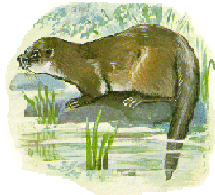
 The
Otter ( Dobharchú) --:
The
Otter ( Dobharchú) --:
The otter lives along riverbanks and beside lakes all around Ireland. It
is very good at swimming and diving. The otter has a small-flattened head,
a long thick neck and a thick tail that narrows to a point.
It can be 3 feet in length, which is about a metre and when they
are fully grown up they can weigh about 20 lbs. It has a long body covered
with fur. It belongs to the same family as the stoat, pine marten and
badger. The otter looks like a seal. The otter is a carnivore, which means
that he usually eats meat and often eats shellfish. To get at the
shellfish,the otter bangs it against a stone. This way he can get at the
food inside. The otter is found in many parts of Ireland. Otters are very
playful animals. It has a grey to brown thick coat of fur, which helps it
swim well in water. They are often seen jumping in and out of water just
for fun, like some of us here in Tramore in the summer.
They are nocturnal animals, which means that they hunt at night. They move around a lot at night and tend to rest by day in their well-hidden homes. Their homes are called a holt. The entrance to the holt is often underwater. A young otter is called a cub or a pup. It takes a cub a few months to learn how to swim. Cubs are blind when they are born. Cubs spend most the time playing in the water. Cubs stay in their home for about eight weeks after they are born. Then its parents bring them outside and teach them how to look after themselves and how to hunt for food. There are usually about two or three cubs in a litter and both parents hunt to feed them.
Some times it looks like
otters are fighting but they are just playing, like some fellows in our
yard at lunch time. The otter is a member of the weasel family. They also
eat frogs and insects. Each otter has five toes. It has webbed feet that
stick to the ground. These webbed feet help it to be a good swimmer. There
are all kinds of otter all over the world. They don’t only play with
each other they also play with stones and fish. The otter is scarce
throughout Europe and its numbers have grown slightly in Ireland over the
years.
It is protected under the Wildlife Act of 1976.
Davey Herbert